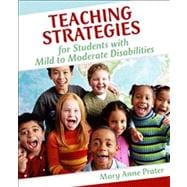
| Learner Characteristics (Mary Anne Prater) | |
| Definitions and Prevalence Rates | |
| Categorical vs. Cross-Categorical Disabilities | |
| Students with Learning Disabilities | |
| Students with Emotional/Behavioral Disabilities | |
| Students with Mental Retardation Students with Attention Deficit Hyperactive Disorder | |
| Multiple Diagnoses | |
| Characteristics that Impact Instruction | |
| Cognitive Characteristics | |
| Memory | |
| Concept Formation | |
| Academic Skills | |
| Social Competence | |
| Motivation and Attribution | |
| Students from Ethnically Diverse Populations | |
| Socio Economic and Family Structure Diversity | |
| Students with Disabilities | |
| Law and Reform Impacting Special Education (Mary Anne Prater) | |
| Key Legislation | |
| Individuals with Disabilities Education Act | |
| Section 504 of the Rehabilitation Act | |
| No Child Left Behind Act | |
| The IEP Process | |
| IEP Team Members | |
| Parent Participation | |
| General Educator Participation | |
| Student Participation | |
| The IEP Document | |
| Present Levels of Academic Achievement and Functional Performance | |
| Annual Goals, Benchmarks, and Short-term Objectives | |
| Special Education and Related Services | |
| Service Delivery | |
| Continuum of Services | |
| Inclusive Education | |
| IEP Review and Revision | |
| Curriculum and Standards | |
| Curriculum | |
| Standards | |
| Access to General Education Curriculum | |
| Universal Design | |
| Aligning Curriculum, Standards and IEPs | |
| Educational Collaboration (Mary Anne Prater) | |
| Models of Working Together | |
| Working to Improve Student Performance | |
| Consultation | |
| Co-Teaching | |
| Working to Improve Teacher Performance | |
| Coaching | |
| Mentoring | |
| Collaboration as a Process | |
| Collaboration Skills | |
| Interactive Communication | |
| Problem-Solving Process | |
| Conflict Resolution | |
| Working with Specific Groups | |
| Paraeducators | |
| Parents and Other Family Members | |
| Collaborating Across Diverse Cultures | |
| Four Cultural Dimensions | |
| Efficiency | |
| Independence | |
| Equity | |
| Communication Styles | |
| Working with Others from Culturally Diverse Population | |
| Behavior and Classroom Management and Organization (Mary Anne Prater) | |
| Behavioral Model | |
| Classroom Management Physical Classroom | |
| Furniture, Materials and the Human Factor | |
| Classroom Ambiance | |
| Effective Time Management | |
| C | |
| Table of Contents provided by Publisher. All Rights Reserved. |
The New copy of this book will include any supplemental materials advertised. Please check the title of the book to determine if it should include any access cards, study guides, lab manuals, CDs, etc.
The Used, Rental and eBook copies of this book are not guaranteed to include any supplemental materials. Typically, only the book itself is included. This is true even if the title states it includes any access cards, study guides, lab manuals, CDs, etc.